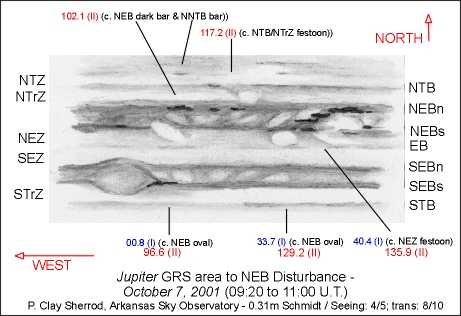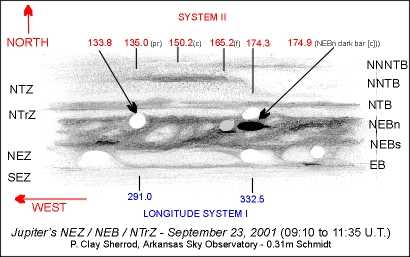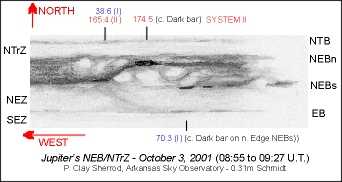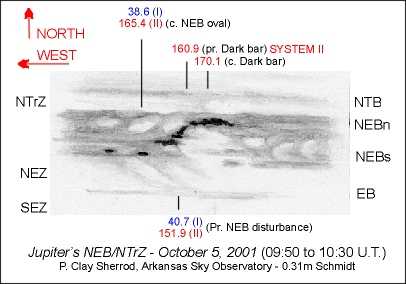OBSERVING THE PLANETS - Part 6
Last updated: 4 November 2001
OBSERVING THE PLANETS - Part 6 |
Jupiter is rising higher and higher in the morning sky and is high overhead at dawn. As it gets closer, more and more detail is being revealed and there is a major disturbance occurring at the present time in the North Equatorial Belt (NEB), as shown in the two drawings that are attached. The first drawing demonstrates the disturbed area of the NEB from September 3, October 3 and October 5; the October 7 drawing demonstrates the area between the Great Red Spot (now very faint orange-pink and visible in even the 3" ETX) and the big NEB disturbance shown on the other drawing. On the latter drawing you can clearly see the disturbance rotating into view.
These drawings, done with the 12" Meade, are oriented as Jupiter will appear in the ETX and LX scopes, with NORTH at top and EAST at the right; therefore, all objects appear on the right and move toward the left as Jupiter rapidly rotates in less than 10 hours around its axis.




There is much color that can be seen on Jupiter right now, and the color becomes richer with more aperture; however, I recommend about 25-30x per inch aperture for maximum image contrast. Although these images were drawn under extremely steady skies at magnifications of between 347x and 620x, do not use more magnification than the conditions will allow a sharp and steady view.
A Wratten #58 green filter is ideal to bring out the GRS and much cloud detail, including many of the brighter white spots shown in these drawings.
For a complete understanding of the methods and nomenclature of Jupiter, I encourage you to download and read my Observing Guide here on the Mighty ETX site at: http://www.weasner.com/etx/buyer-newuser-tips/planets-jupiter.html (Part I) and at http://www.weasner.com/etx/ref_guides/jupiter2.html
You will see that there is considerable information that can be provided by the amateur astronomer toward the body of knowledge of the Giant Planet. To keep up with the latest announcements, alerts of disturbances, etc. there is a new Yahoo group at: http://groups.yahoo.com/group/ALPO_Jupiter which is coordinated through the Association of Lunar and Planetary Observers Jupiter Section ( www.lpl.arizona.edu/~rhill/alpo/jup.html ). Visit the ALPO web site at this URL to learn more about observing Jupiter and for free downloads of Red Spot transit times, the Jupiter Newsletter, and even forms for electronically filing your valuable observations.
P. Clay Sherrod
Arkansas Sky Observatory
sherrodc@ipa.net
Subject: Your Guide to Jupiter 2001-2002 Sent: Friday, November 2, 2001 5:27:26 From: sherrodc@ipa.net (Clay Sherrod) A lot of observers have remarked about difficulty seeing the Great Red Spot (GRS) on Jupiter in this early part of the 2001-2002 apparition of the great planet. The spot has, indeed, faded substantially (actually beginning after 1975), but still can be distinctly seen as a football-shaped oval intruding into the "double-lined" and nearly perfectly parallel South Equatorial Belt. Many observers, particularly those with very small telescopes can see this feature by noting where it is "supposed to be," since it actually is physically "pushing" the southern component of the twin SEB northward, and creating a "bay" that is distinctly visible in small scopes. At the Arkansas Sky Observatory web page (www.arksky.org) , we have extended our Images Archives to include real-time data from the latest observations. From this you can key in EXACT longitudes of any feature on Jupiter you want to see the past and present appearance of these features. For example, presently the GRS is located at Longitude II 72.9degrees; merely type in that value in the appropriate CM window and press enter to see all images for that particular part of the Jovian surface. This unique observing index is available at: http://www.arksky.org/asoimglib.htm . Throughout the current apparition, this Archive will grow greatly and provide YOU with an opportunity to compare observations and images. P. Clay Sherrod - sherrodc@ipa.net Arkansas Sky Observatory www.arksky.org
Return to the top of this page.
Go back to the Observational Guides & References page.
Go back to my ETX Home Page.